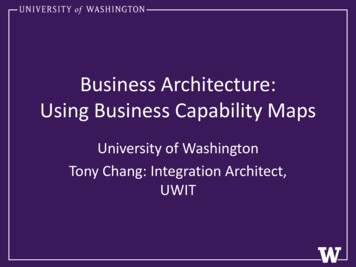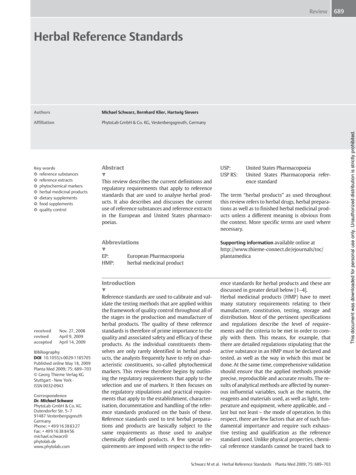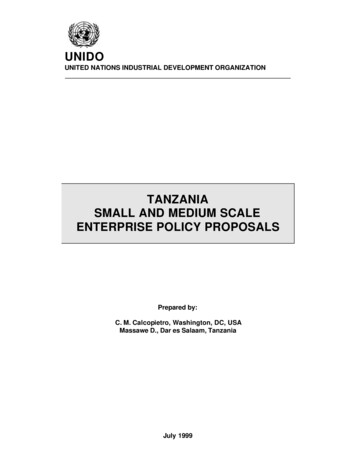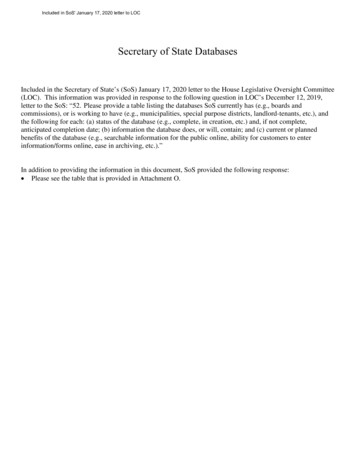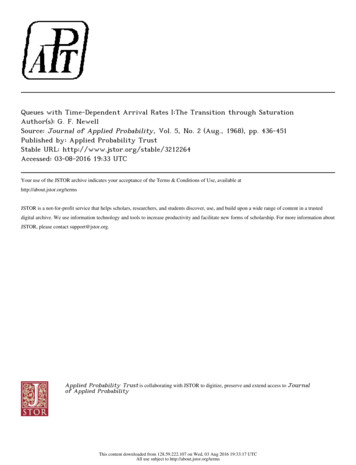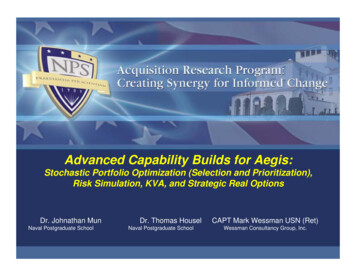
Transcription
Advanced Capability Builds for Aegis:Stochastic Portfolio Optimization (Selection and Prioritization),Risk Simulation, KVA, and Strategic Real OptionsDr. Johnathan MunNaval Postgraduate SchoolDr. Thomas HouselNaval Postgraduate SchoolCAPT Mark Wessman USN (Ret)Wessman Consultancy Group, Inc.1
Introduction and Context Introduction of Open Architecture (OA) business and technicalprocesses provides opportunity to improve acquisition– Increased competition– Shorter cycle time– Reduced total ownership and acquisition cost The AEGIS Advanced Capability Build (ACB) process is oneimplementation of the OA approach2
The ACB Process The ACB process provides for software updates to ships withinthe program on a two-year cycleACBs are identified by the first year in which they will be fielded,e.g., ACB-14 US Navy CGs and DDGs will be inducted into the processas they receive computing plant updates during majoravailabilities that convert the processors and networks to aCOTS-based configuration The hardware baseline that supports OA must be in placeto begin execution of the ACB process Once a ship is inducted, it will receive the scheduledupdate plus any previous updates (e.g., ACB 16 shipsentering the program will receive ACB 14 capabilities aswell)3
The problem addressed in this study dealswith risk and value Value is realized through fielding of military capability for the war-fighterRisk is found in uncertainty– Cost uncertainty creates budget risk– Technology risk can lead to schedule and budget risk This study provided a pilot implementation of the Knowledge ValueAdded Integrated Risk Management method to represent value andrisk to assist the PM and sponsor in selecting the proper capability mixto field in a given ACBThe problem space considered 23 capabilities to be implementedthrough changes to 32 software components across three scheduledACBs (ACB 14, 16, and 18)Given the universe of desired capabilities, the problem is to selectthose providing the best value to the war-fighter for inclusion in a givenACB subject to budget constraints, risk and uncertainty of cost andtiming4
The study articulated a notional value of military valueand used powerful financial and analytical tools Knowledge Value Added (KVA) provides ways of representingoutputs (value) in common unitsReal Options provides tools to compare the value stream ofvarious options in rigorous termsIntegrated Risk Management considers uncertainties andrepresents risk in quantitative, clear and defensible terms5
As ships enter the program and ACBs areexecuted, military value is additive6
One advantage of the ACB process is the“catch-up” effect The ACB process helps managerisk by allowing the PM andsponsor to delay introduction ofa particular capability until it isready without waiting manyyears for the next cycleA delay until the next ACB ismore acceptable because withinfive years the number of shipswith the capability will be thesame7
The remainder of this presentation discusses theanalysis and results Assumptions and constraintsMeasurement of military value (KVA)Application of Real Options and Integrated Risk Management(IRM) to the selection of capabilities8
Assumptions and Constraints The study applied the following initial assumptions– The capabilities were independent of each other– Capabilities were implemented through changes to modules withinthe objective architecture Initial constraints assumed– A notional integration budget of 150 million per ACB– All uncertainty estimates for the initial model were based on costvolatility Future study will include– Effects of interdependencies (nested options), correlations,diversification– Schedule risk– Opportunity cost and penalty costs of abandonment9
Measuring Value KVA quantifies the value of the knowledge used to producecommon units of outputShows decision makers the benefit and cost of each programor projectMeasures how resources are allocated on the volatility ofproductivity (e.g., ROI)Providing ROI volatility inputs to IRMMilitary value in this study was postulated to be represented bycapability provided to the warfighter measured in a variety ofways– Strategic importance as represented by OPNAV sponsor priorities– Technical value as represented by acquisition community priority– Functional complexity represented by Delivered Source Lines of Code(DSLOC)– Subject Matter Expert evaluation of complexity and mission criticality,aggregated from the component level10
Integrated Risk Management ProcessFramingReal Options6Options analytics,simulation, optimizationSimulationshare realized label Volatility technical risk Market Value Project Value- market sizeelasticity prevalenceprice--competition developmental testing R&D Cost Post-P3 Cost Time to P3 the relevant projectsare chosen for realoptions analysis and theproject or portfolio realoptions are framed the user generates atraditional series of static basecase financial (discounted cashflow) models for each project with the assistance oftime-series forecasting,future outcomes can bepredicted.LatticeReal Options SuperLattice Solver real options analytics arecalculated through binomial latticesand closed-form partial-differentialmodels with simulation 7Portfolio optimizationand asset allocationOptimizationRiskSimulatorEffects of GoingOther opportunitiesRevenue enhancementLoss revenuesLoss cost reductionLoss of marketleadershipCost reductionDecisionStrategic options valueStrategiccompetitivenessHigh cost outlay stochastic optimization is thenext optional step if multipleprojects exist that require efficientasset allocation given somebudgetary constraints useful forstrategic portfolio management RiskSimulatorSimulation Monte Carlo simulation is addedto the analysis and the financialmodel outputs become inputs intothe real options analysis 8Effects of WaitingDefray costDynamic MonteCarlo simulation4RISK ANALYSISTime Series ForecastingDevelop staticfinancial modelsRISK MANAGEMENTStart with a list of projectsor strategies to beevaluated these projectshave already been throughqualitative screeningRiskSimulator3Traditional analysis stops here!ABCDEBase case projectionsfor each projectRISK MODELINGRISK PREDICTION2RISK DIVERSIFICATIONRISK MITIGATION5List of projectsand strategies toevaluateRISK HEDGINGRISK IDENTIFICATION1Reports presentationand update analysisPeriodFirst Cash FlowDiscounted Value ofDiscounted Value of theInterest RateDCF ValueStarting (t)(t 3)Future Cash FlowsCosts to InvestOpportunity Cost(monthly basis)Phase II OptionsRetirementPersonal FinancialsPrivate LoansAcademic 040.949%0.87%Optimal ExerciseStandardValue of theDeviation of"Discounted ValueOption Value at tOption Value at t 0ActualizedDecision To InvestCFParameterof the Costs toCash ,7881.263Execute InvestmentWait to it to InvestWait to Invest create reports, makedecisions, and do it allagain iteratively over time 11
KVA RO IRM are a combination of method andtoolset to assist the PM in decision making Knowledge Value Added (KVA) is a method that systematically expresses nonrevenue activities in common units of output to quantify valueReal Options (RO) provides a way to qualitatively and quantitatively evaluate therelative value of various courses of action under considerationIntegrated Risk Management combines KVA and RO with a powerful toolset to assistthe program manager in the decision processTreatment of parameters as distributions permits rigorous analysis in an uncertainworld, where instead of single point estimates, we use ranges as inputsMonte Carlo risk simulation and process models permit consideration of all possibleoutcomes within a reasonable time periodDisciplined processes yield defensible results that can be updated as moreknowledge/ information is realized by the programRisk simulation, sensitivity analysis, and forecasting are automated (analyses areefficient, quick, consistent, replicable, defensible, and scalable)The toolset and method provide a way for the PM to determine the relative merits of thevarious options available, to make informed choices based on value streams and risk, andthen to articulate those choices to the sponsor and the acquisition chain of command.12
Model input assumptions areentered on a data sheetCommon sizing inputs and using weightsto obtain the expected military valueStarting with 23 capabilitiesTechnical and(more to be added laterOPNAV prioritieswhen there is sufficient data)High, most likely, low costDSLOC provides a measureestimates for runningof complexitythousands of simulation trialsIntermediate computations: risksimulation assumption, readjustedpriorities, expected military scoreand cost-based risk coefficients13
Running the model provides recommended selectionsACB 14 sample results with 150M budget constraintSelection of EMVcalculation methodGo or No-Godecisions in theportfolio selectionBenefits (EMV),Cost, Risk areconsideredConstraints can be set (budget,capability count, FTE, priorities, etc)Starting with 23 capabilities (more to beadded later when there is sufficient data)14
Portfolio optimization analysis gives a set of solutionsAn Efficient FrontierAnalysis providesoptimal selection for avariety of budgetpossibilities15
Risk simulation of cost provides the decision maker with additional dataRisk analysis and100,000simulation trialson costestimations We candetermine theprobability thatACB-X willexceed the 150Mbudget,determine what 171M will yield a99% certainty ofsufficient budgetto cover all costsWe also looked atthe optimalportfolio given a90% probabilitythat 150M will beenough*Screen shots from Risk Simulator software16
Optimized portfolios are time-sequenced and risks are quantified17
More complex options and constraints can be accommodated in the analysesInclusion of Analysis ofAlternatives or Coursesof Action usingstrategic real optionsanalysis of variousimplementationpathways, suitable fornested and pathdependent options(some components andcapabilities areinterdependent) Risk can be mitigated or planned for though– Budgeting to the amount that the simulator reveals isnecessary to provide a given level of risk– Improving cost estimate quality and reducing volatility– Up-front action to change the cost equation Contractual limits on cost through use of fixed price orother contract vehicles to shift risk with the vendorIncentives to the contractor that reward for success andpenalize for failure to meet cost targetsCapability selection can also be accomplished by applying riskconstraints during the optimization18
Going forward More complex analyses to determine which optimizationportfolio to choose– nested and mutually exclusive options among and between variouscapabilities– expansion options of a base capability into additional capabilities Strategic real options approach to generate differentimplementation pathways– provide strategic option trees– identify best decision strategic option pathway19
Back up slides
Risk Simulation (Risk Management) shows the range of likely outcomes21
Risk Analytics (sensitivity, tornado, fitting, and many otheranalytical tools) provide depth of understanding22
Advanced Capability Builds for Aegis: Stochastic Portfolio Optimization (Selection and Prioritization), . and strategies to evaluate Start with a list of projects or strategies to be evaluated these projects . Option Value at t Option Value at t 0 Actuali



